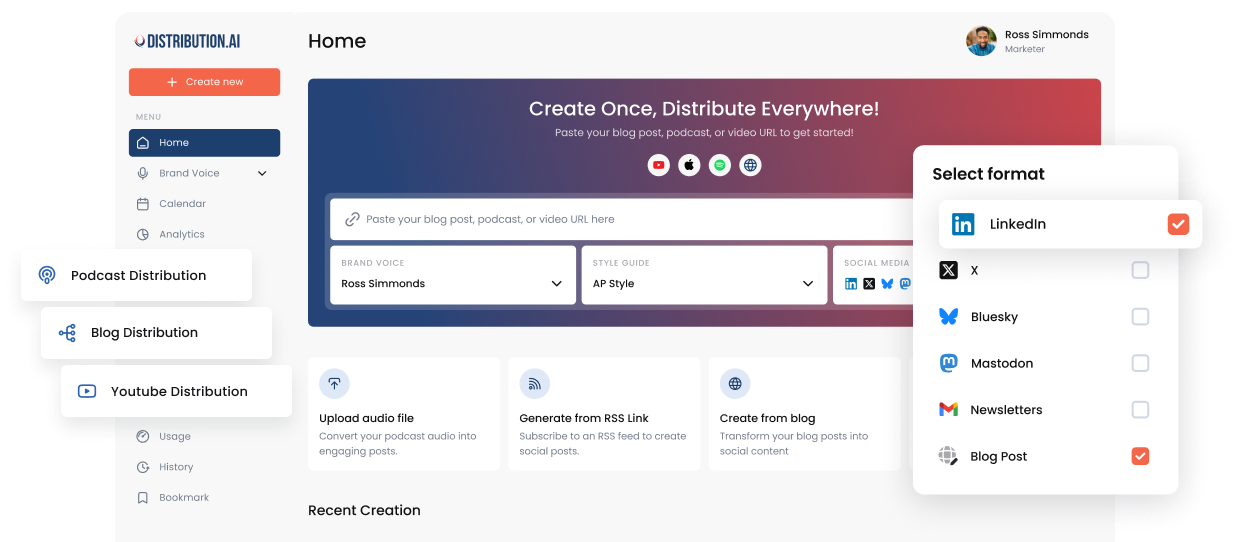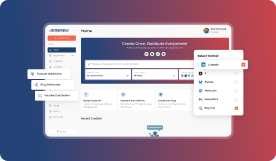What Is Growth Marketing and Why Every Business Needs It?
What is growth marketing? Discover how you can implement growth marketing strategies to drive sustainable, scalable business growth across the entire funnel.

Most businesses often fall into the trap of chasing vanity metrics while struggling with high customer acquisition costs, poor retention, and stagnant revenue growth.
Where traditional marketing often stops at top-of-funnel awareness, leaving gaps in the customer lifecycle growth marketing solves this problem by evaluating the entire marketing funnel—acquisition, activation, retention, referral, and revenue.
Growth marketing is less about quick wins and more about building systems that scale sustainably, turning potential customers into loyal brand advocates. By combining data, experimentation, and cross-functional collaboration, businesses can uncover what truly drives results and double down on strategies that accelerate growth.
What Is Growth Marketing?
Growth marketing is a data-driven approach that focuses on sustainable business growth by testing, measuring, and optimizing every step of your customer experience—from first discovery to long-term retention.
Unlike traditional marketing, which works in silos, growth marketing connects all your marketing efforts into one system. It uses continuous experimentation to find what actually works, then scales those winning strategies across your entire marketing funnel.
How does growth marketing work?
Growth marketing tests new ideas, analyzes the results, and applies successful tactics company-wide. It establishes a cycle of continuous improvement where every marketing decision is backed by real data. This holistic approach is iterative and agile, allowing businesses to adapt quickly to market changes and customer feedback.
By adopting growth marketing, you can:
- Identify what works and what doesn’t to prevent investing time and resources in ineffective strategies
- Focus on the entire customer journey and not just acquisition
- Scale growth with rapid testing and adaptation of successful tactics across channels
- Continuously optimize touchpoints to improve customer experiences
- Build long-term systems instead of one-time campaigns
What are the Key Components of Growth Marketing?
Growth marketing teams use a data-driven and customer-centric approach. They leverage data analytics and targeted experimentation to ensure sustainable company growth. Let’s look at the key elements that comprise the process.
Data and analytics
- Track behavior flow, attribution models, and funnel drop-offs using tools like Google Analytics.
- Use social listening tools to shape your growth marketing strategy—audience insights, collaborations, combined with AI, can help you capture trends before they scale.
- Focus on actionable metrics, such as customer acquisition cost and customer lifetime value progression.
- Build dashboards that help identify loopholes or deviations to enable real-time strategic decision-making.
Experimentation frameworks
- Use ICE scoring (Impact, Confidence, Ease) to prioritize which tests to start with.
- Experiment with something small and simple, such as testing one email subject line change and measuring one conversion metric.
- A/B test different versions of marketing assets, such as emails, social media content, growth marketing campaigns, or webpages, to see which version works the best.
- Build a baseline library, documenting methodologies, metrics, and implementation insights.
This is where a social media management tool like Distribution.ai really shines. Experiment by scheduling posts at the recommended times and tracking post performance to see what works best for your target audience.
Technology and tools
- Create an interconnected system of tools. Connect CRM, testing, and analytics to enable rapid iteration.
- Make sure each tool feeds clean data into your central analytics platform.
- Choose integrated solutions that can scale with your growth marketing experimentation needs.
Cross-functional teams
- Growth marketing insights come from cross-functional collaboration—support tickets reveal friction points, product usage data shows activation patterns, sales calls uncover positioning gaps.
- Create regular cross-team sync meetings where customer-facing teams share qualitative insights while analysts provide quantitative context.
- Focus on collaboration across sales, product, support, and marketing for comprehensive customer understanding.Using advanced product management tools can make this collaboration more seamless, helping teams share insights and stay aligned on customer needs.
Customer journey mapping
- Map touchpoints from awareness through advocacy, identifying optimization opportunities at each transition stage of the customer lifecycle.
- Use behavioral triggers—exit-intent popups for browsers, re-engagement emails for dormant users, loyalty rewards for advocates.
- Implement dynamic segmentation and use different strategies for prospects, active users, and churning customers.
- Make small improvements on transition moments to impact retention and generate referrals.
Growth Marketing in Action: Facebook’s ‘7 Friends in 10 Days’ Strategy
Facebook identified a crucial onboarding milestone: Users who added at least 7 friends within their first 10 days of signing up were significantly more likely to become engaged long-term users. This metric became their activation milestone—a trigger that drove user behavior toward becoming active members of the platform.
Tracking this moment, Facebook aligned the entire team—product, growth, marketing—around nudging new users to reach that threshold as quickly as possible. This small but powerful shift in onboarding led to a dramatic increase in long-term retention and contributed to Facebook scaling to over 1 billion users.
Growth Marketing vs. Traditional Marketing
Traditional Marketing focuses on awareness and acquisition through static campaigns, often relying on annual plans with limited flexibility.
Growth Marketing engages customers at all stages of the funnel—acquisition, activation, retention, referral, and revenue (AARRR framework). It uses real-time data to continuously optimize strategies and foster customer relationships.
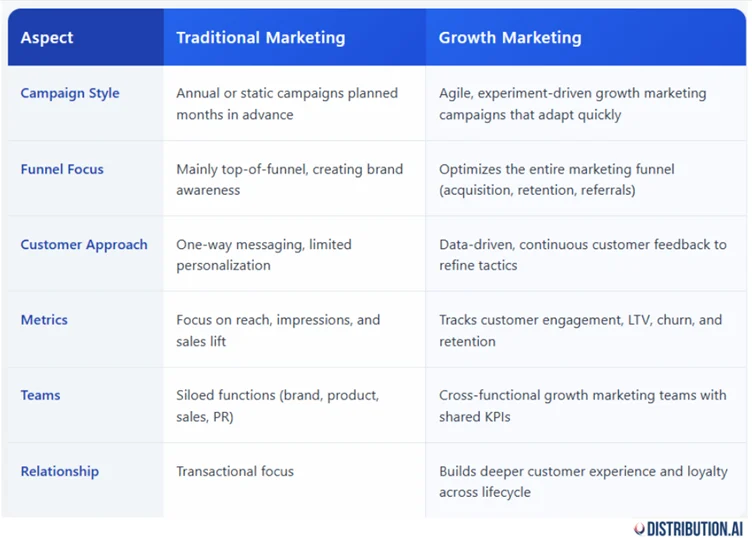
Core Principles of Growth Marketing
A growth marketing manager use these core principles to attract, convert, and retain customers.
Customer-centricity at the core
As Peter Drucker stated, “The aim of marketing is to know and understand the customer so well that the product or service fits him and sells itself.” This philosophy remains the foundation of successful growth marketing today.
Placing customers at the center of all strategies ensures that marketing efforts align with customer needs and preferences. This approach fosters loyalty and drives sustainable growth. In fact, data suggests that customer-centric brands report 60% higher profits.
Data-driven decision-making to reduce risk
Marketers are increasingly relying on data to inform their strategic decisions. That’s because companies using customer data-based personalization techniques exceeded their revenue goals 83% of the time.
Utilizing analytics to guide actions and measure success allows marketers to make informed decisions. By analyzing customer behavior and campaign performance, strategies can be refined for better outcomes.
Experimentation to discover opportunities
Mike Volpe advised, “Don’t be afraid to get creative and experiment with your marketing.” That’s exactly what growth marketing is all about—process, test, and implement.
Employing A/B testing and other methods to refine tactics encourages a culture of continuous improvement. It improves customer engagement and boosts bottomline returns as well. In fact, research suggests that 65% of companies reported that using A/B testing systematically improved their conversion rates by 10% or more. Plus, they witnessed a 15-25% increase in key engagement metrics.
Cross-functional collaboration for a unified customer experience
Once David Packard noted, “Marketing is too important to be left to the marketing department.” This indicates that marketing works best when unified, rather than in silos.
Aligning marketing with product, sales, and customer success teams ensures cohesive execution and a unified customer experience. This collaboration brings everything under one roof and leverages diverse expertise for holistic growth strategies.
How To Do Growth Marketing?
Implementing a growth marketing strategy requires a structured approach that combines strategic planning with tactical execution.
Define your growth vision
Start with a clear picture of where you want your business to go. Your growth vision should connect directly to your bigger business goals and guide every marketing decision you make.
For instance, if you’re a startup wanting to increase brand awareness, start with social media marketing. Reach your target audience via social media platforms where they’re most active, such as LinkedIn for B2B businesses, Instagram for D2C fashion brands, etc.
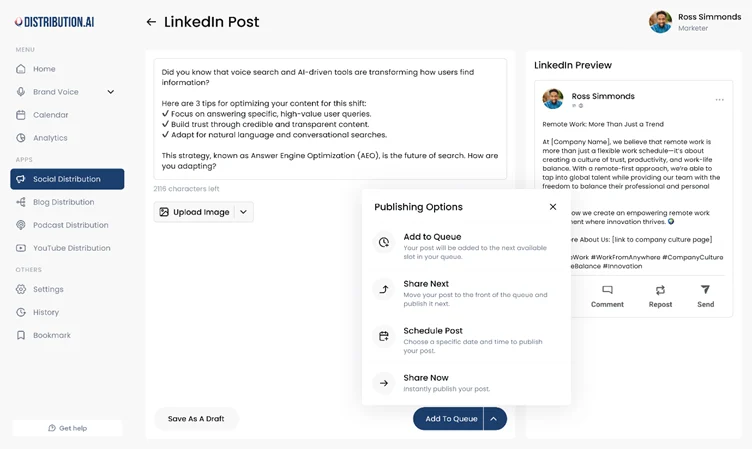
Set measurable goals
Transform your growth vision into specific, measurable objectives using the SMART criteria—Specific, Measurable, Achievable, Relevant, Time-bound. For example, aiming to increase customer retention by 20% within six months provides a clear target and timeframe, facilitating focused efforts and resource allocation.
Conduct market research
Employ surveys, focus groups, and analytics tools to understand your audience’s needs and behaviors and gather actionable insights. This research informs your strategies and helps identify high-impact opportunities. For example, recognizing that Gen Z consumers demand frictionless eCommerce experiences and culturally relevant branding can guide your marketing tactics.
Develop a growth model
Craft a customized growth model that delineates how various marketing activities contribute to overall business growth.
Utilizing frameworks like the AARRR (Acquisition, Activation, Retention, Referral, Revenue) funnel allows you to map the customer journey comprehensively. This model ensures that each stage of the funnel is optimized for maximum impact.
The AARRR framework, also known as the Pirate Metrics model, is a strategic tool used in growth marketing to analyze and optimize the customer journey. Developed by Dave McClure, it segments the journey into five key stages:
- Acquisition: Attracting potential customers through various channels
- Activation: Ensuring users have a positive initial experience
- Retention: Keeping customers engaged over time
- Referral: Encouraging customers to refer others
- Revenue: Generating income from customers
By systematically addressing each stage, businesses can identify areas for improvement and implement targeted strategies to drive sustainable growth.
Experiment strategically
Foster a culture of experimentation to test hypotheses about growth drivers. Implement A/B testing and other experimental methods to refine your tactics. For instance, Slack’s initial strategy involved inviting organizations to request access during its beta phase, resulting in 8,000 signups within 24 hours. Over the next six months, Slack gathered feedback from these users to refine the product, exemplifying effective experimentation leading to growth.
Optimize continuously
Regularly analyze results from your experiments and campaigns. Use data-driven insights to refine your strategies in real time. If a particular approach underperforms, adjust your tactics accordingly. For example, if a referral program isn’t yielding expected results, consider tweaking the incentives or messaging to enhance its effectiveness.
Examples of Growth Marketing Strategies
Here are actionable strategies you can implement:
1. Content marketing funnel
Developing content tailored to each stage of the customer journey enhances engagement and conversion rates. For instance, HubSpot employs a comprehensive content marketing funnel:
- Awareness stage: HubSpot attracts potential customers by offering high-quality, free resources such as blogs, eBooks, and webinars that address common pain points in marketing and sales.
- Consideration stage: They provide in-depth guides and case studies that delve into specific solutions, helping prospects evaluate their options.
- Decision stage: HubSpot offers free trials and product demonstrations, allowing prospects to experience their software firsthand before making a purchase decision.
This structured approach guides prospects through the funnel, increasing the likelihood of conversion.
2. Referral programs
Encouraging existing customers to refer new ones can significantly boost growth. Dropbox’s referral program is a notable example:
- Dropbox offered additional storage space to both the referrer and the referee (500 MB for Basic users and 1 GB for Plus), incentivizing users to invite friends and family.
- This dual-sided incentive led to a substantial increase in user acquisition, contributing to Dropbox’s rapid growth.
By rewarding both parties, Dropbox created a win-win situation that encouraged widespread sharing.
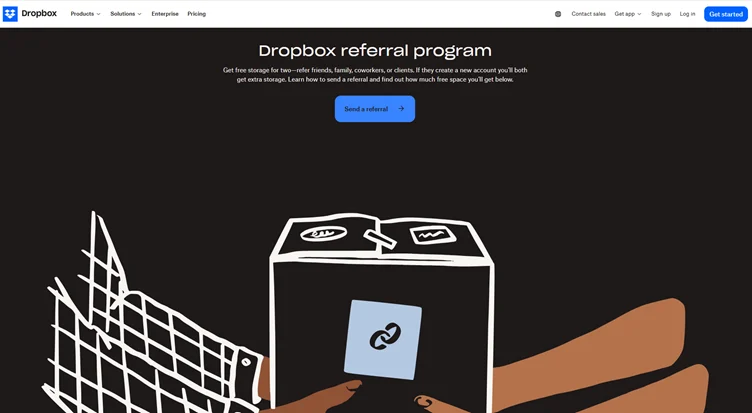
3. Personalization
Utilizing AI-driven tools to deliver personalized experiences can enhance customer engagement. Adobe, for example, leverages its AI models to drive personalization:
- Adobe’s AI-powered tools enable marketers to create personalized content at scale, tailoring experiences across email marketing, social media, and websites.
- This approach helps in delivering relevant content to users, improving engagement and conversion rates.
By integrating AI, Adobe empowers businesses to meet individual customer needs effectively.
4. Freemium Models
Offering basic features for free while charging for premium functionalities can attract a broad user base. Slack’s approach illustrates this strategy:
- Slack provides a free version with essential features, allowing teams to experience the platform without any initial investment.
- As users become accustomed to the platform, they may opt for premium plans to access advanced features, facilitating revenue growth.
This model lowers the barrier to entry and enables users to realize the product’s value before committing financially. By adopting these strategies, companies can effectively nurture leads, encourage customer advocacy, deliver personalized experiences, and convert free users into paying customers, driving sustainable growth.
Metrics To Track in Growth Marketing
In growth marketing, tracking specific metrics across the customer journey is essential for evaluating and enhancing performance. The AARRR framework—Acquisition, Activation, Retention, Referral, and Revenue—provides a structured approach to this process. Below is an overview of key metrics associated with each stage:
Acquisition
Cost Per Lead (CPL): This metric calculates the average expense incurred to acquire a new lead. It is determined by dividing the total marketing costs by the number of leads generated. Monitoring CPL helps in assessing the efficiency of marketing campaigns.
CPL = (Total marketing costs)/ Number of leads
Conversion Rate: This measures the percentage of visitors who complete a desired action, such as signing up or making a purchase. It is calculated by dividing the number of conversions by the total number of visitors and multiplying by 100. High conversion rates indicate effective marketing and user experience strategies.
Conversion = (Total number of conversions)/ Total number of visitors
Activation
Time-to-Value (TTV): TTV gauges the duration it takes for a new user to realize the value of a product or service. Shorter TTV can lead to higher customer satisfaction and an increased likelihood of retention.
TTV = Time of value realization – Time of product signup or activation
Here, “value” should be clearly defined. It can be a specific action, an outcome, or a customer experiencing the core product benefits.
Activation Rate: This metric represents the proportion of users who reach a predefined activation milestone, such as completing a tutorial or using a key feature for the first time. A higher activation rate suggests that users are effectively engaging with the product early on.
Activation rate = (Number of activated users/ Total number of users) x 100
Here, activation refers to new users performing a specific task within a given timeframe, such as sending 10 messages within 7 days or making a purchase within 3 days of signing up.
Retention
Churn Rate: Churn rate indicates the percentage of customers who discontinue using a product or service over a specific period. It is calculated by dividing the number of customers lost during a period by the total number of customers at the start of that period, then multiplying by 100. Lower churn rates are indicative of successful retention strategies.
Churn rate = (Lost customers during a period/ Total customers at the start of the period) x 100
Repeat Purchase Rate: This measures the percentage of customers who make more than one purchase within a given timeframe. A higher repeat purchase rate signifies more loyal customers and higher satisfaction.
Repeat purchase rate = (Number of repeat customers/ Total customers) x 100
Referral
Net Promoter Score (NPS): NPS assesses customer loyalty by asking how likely customers are to recommend the product or service to others on a scale of 0 to 10. It is calculated by subtracting the percentage of detractors (scores 0-6) from the percentage of promoters (scores 9-10). A higher NPS indicates a greater likelihood of referrals.
NPS = Percentage of detractors – Percentage of promoters
Referral Rate: This metric tracks the percentage of new customers acquired through existing customer referrals. It is determined by dividing the number of referred customers by the total number of new customers, then multiplying by 100. A high referral rate reflects effective word-of-mouth and referral programs.
Referral rate = (Number of referred customers/ Total customers) x 100
Revenue
Customer Lifetime Value (CLV): CLV estimates the total revenue a business can expect from a single customer account throughout its relationship. It is calculated by multiplying the average purchase value, purchase frequency, and customer lifespan. Understanding CLV helps make informed decisions about customer acquisition spending.
CLV = (Average purchase value) x (Average purchase frequency) × (Average customer lifespan)
Monthly Recurring Revenue (MRR): MRR represents the predictable revenue a company expects to receive monthly from subscription-based services. It is calculated by multiplying the total number of active subscribers by the average revenue per user (ARPU). Monitoring MRR is crucial for assessing the financial health and growth trajectory of a business.
MRR = Total active subscribers x Average revenue per user
By diligently tracking these metrics, businesses can gain valuable insights into their growth marketing efforts, allowing for data-driven decisions and strategic adjustments to optimize performance across the customer lifecycle. Leveraging order to cash software further enhances this process by automating revenue tracking, ensuring accurate recognition, and providing real-time insights from customer acquisition through to cash collection.
Growth Marketing Tips to Keep Progressing
Here are a few high-impact, actionable tips that can help you scale your growth marketing initiatives.
Launch newsletters to build a direct, engaged audience
This is a Redditor’s tip. It mentions that newsletters can be an incredible tool for an effective growth strategy. They allow you to build and engage a dedicated audience directly. This creates a consistent touchpoint that nurtures potential customers and fosters trust.
Prioritize analytics first and map the buyer journey
Start with data. Identify the KPIs (Key Performance Indicators) that matter most, then align them with the customer journey. Mapping acquisition to retention touchpoints helps refine your funnel and reveal the opportunities that will benefit you the most.
Encourage shareability for customers to market for you
Products and campaigns that are easy to share create organic referral loops. Small features like customizable reports, social sharing prompts, or incentives for referrals can turn existing customers into your best acquisition channel.
Start with one goal and one channel
Growth marketing thrives on clarity. Pick one measurable goal and focus on a single channel until you see traction. This avoids dilution, speeds up learning, and makes results easier to attribute.
Create strong copies that resonate with your target audience
Strong copy drives performance across ads, landing pages, and emails. Investing in persuasive, customer-focused messaging ensures higher engagement and conversion at every stage of the funnel.
Final Thoughts
Growth marketing is not just about acquiring customers; it’s about building lasting relationships that drive sustainable growth. By focusing on data-driven insights, continuous experimentation, and customer-centric strategies, businesses can unlock their full potential.
Whether you’re a startup chasing rapid expansion or an established business aiming for steady revenue growth, adopting a growth marketing mindset can reshape your trajectory. Start small with focused experiments, measure relentlessly, and always optimize for the bigger picture—the customer lifecycle.
And if you’re looking for a partner in this journey, Distribution AI can help. From generating copies for social media ads to creating social media posts and repurposing blogs, videos, or podcasts, it equips growth marketing teams with the leverage to scale smarter. In short, it handles the heavy lifting, allowing you to focus on customer engagement, retention, and informed decision-making
Frequently Asked Questions
Promote, repurpose & distribute your content with AI
Start 15-Day Free Trial